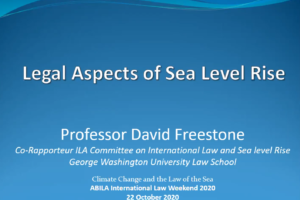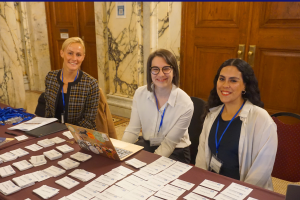Empowering Law in Earth System Models – Powerless law or law for the powerless? An Environmental and Energy Perspective

This piece is part of the American Branch’s first blogging symposium, examining the ILW 2024 theme of ‘Powerless law or law for the powerless?’ from an International Environmental and Energy Law perspective.
Empowering Law in Earth System Models
by Yirong Sun*
Earth system models are increasingly used not only for advancing scientific understanding of global environmental changes, as seen in the IPCC assessment reports, but also for designing climate change adaption measures like early warning systems for hazards, and providing guidance for policy and decision-making at global, regional, and national levels, such as Destination Earth for green transformation in the EU, and forest adaptation and management in Canada.
Reflecting the development in Earth System science, Earth System Law scholars are setting ambitious research agendas to address the challenges of the Anthropocene by proposing legal transformations grounded in an Earth System perspective, including a reimagination of international environmental law.
While these proposals are promising, it remains to be seen if they challenge the power dynamics in science-making that inform global environmental governance. The identification and understanding of global environmental crises have long depended on science. International environmental law has traditionally focused on providing institutional support for environmental science rather than engaging in the substantive processes of its norm creation.
This blog argues for a paradigm shift by referring to the Global Data Law and Infrastructure as Regulation (InfraReg) project at New York University School of Law.
Empowering law in Earth System Models means establishing a bidirectional relationship between law and Earth system science. (Re-)Claiming law’s territory is essential, as environmental physical models often form the conditions for and couple with social system models to project futures of human societies. The scenario models developed by the IPCC are particularly influential as they are widely embraced by central banks, financial institutions, and corporations with gigantic climate governance impacts, while receiving no scrutiny from international law.
This blog will unpack the argument with three scenes: global epistemic infrastructures, data inequalities, and the struggle of scales.
Global Epistemic Infrastructures
The relationship between law (or broader policy-making) and boundary organizations like the IPCC and the IPBES is traditionally understood as separate, a condition many theorists believe is necessary for science to maintain its objectivity and “speak the truth.” This separation accompanies the technocratic international thought, where issues like transmissible diseases, chemicals, and environmental problems are subleased to a network of experts for solutions in international governance.
However, global environmental knowledge production is plagued by power imbalances created by epistemic infrastructures and accompanying culture that marginalize certain forms of social scientific knowledge, leading to a hierarchy in disciplinary knowledge. There are further disparities in participation between Northern countries and the Global South, and although there is now more recognition, Indigenous knowledge systems remain marginalized (see here, here, and here). Despite rising awareness in social science and humanities about these epistemic infrastructures, international law has primarily remained unresponsive. In emerging climate litigation trends, the work of the IPCC is often accepted wholesale as reflecting scientific consensus, as demonstrated by the recent ITLOS Advisory Opinion:
“With regard to climate change and ocean acidification, the best available science is found in the works of the IPCC which reflect the scientific consensus. As noted in paragraph 51 above, most of the participants expressed the view that the IPCC reports are authoritative assessments of the scientific knowledge on climate change and referred to them in their pleadings in the present proceedings. […]” (para 208, emphasis added)
Global epistemic infrastructures represent dominant ways of global knowledge re-production and circulation using Earth system models for its physical science foundation, coupled with socio-economic models for assessment. Earth system models continue to evolve, but they are not perfect and likely never will be. The role that law should play in this process is not to verify the correctness of scientific results as it cannot – but to ensure justice through fair and equitable processes in knowledge production and circulation. The right to science could be a starting point, leveraging existing legal tools for power rebalancing. Learning from recent experiences with the IPBES, the law may even intervene further, as the approval process for the text of “summary for policymakers” almost transformed this inter-governmental expert body into negotiation sites for draft articles and resolutions.

Data Inequalities and Risks of Extraction
Earth system science, which provides the scientific foundation for understanding today’s global environmental challenges, fundamentally relies on data and modeling. However, the availability and generation of this data are largely unequal across both temporal and spatial dimensions.
These data inequalities stem from disparities in the “power to data-fy” and control over data. One easily identifiable cause is the uneven development of data infrastructures, particularly terrestrial-based observing networks. Time-sensitive model applications, such as early warning systems, require timely and accurate terrestrial observations, which many low-income regions cannot afford, leaving their populations particularly vulnerable.
Moreover, the data input in Earth system models spans various timeframes, often including decades-old data managed by municipal agencies, such as grazing and land management practices. This data is frequently unavailable due to a lack of stable governmental agencies to maintain such records, initial non-generation, loss during conflicts, or concerns over sovereignty and security. For Indigenous lands, the use of such data might lead to further extractive operations without right-owners’ consent, when Indigenous people have already suffered disproportionately from global extractive and industrial projects.
Though likely well-informed about data gaps in their research, scientists must be better positioned to address data inequalities in the face of global environmental challenges. They are trained to work with the best available data and address data inefficiencies by employing proxies, analytical methods, or derivatives. While scientists can identify needs within their community, legal mechanisms to ensure equal data generation and more equitable data governance are needed to address the socio-legal concerns mentioned above.
As more groups outside academia mobilize to use and apply available scientific knowledge, the accelerated circulation of scientific findings and an expanded audience and downstream user groups amplify the dangers of data gaps. Scientific findings generated through Earth system models are often conscious of the compromises made in their data input and model design, accompanied by carefully drafted limitations and scope of application. However, as these findings circulate downstream, the data gaps can evolve from mere limitations into tangible impacts on people’s daily lives.
It is thus crucial for law – particularly international law and institutions – to recognize these data inequalities on a global scale. Legal intervention is needed to build capacity and establish more equitable data governance regimes. This is especially important as efforts toward adaptation and mitigation in the Anthropocene increase, particularly initiatives from highly industrialized areas where advanced sensors are readily available.
A Constant Struggle of Scale
In Earth system models, Earth is represented, simulated, and projected using grid-boxes as the basic unit. Although approaches vary and Earth system science is continually evolving, specific patterns and legacies persist in many models today and in the trending Earth Digital Twin initiatives, as identified by Deborah Coen and Fredrik Albritton Jonsson in Between History and Earth System Science:
“We might characterize the geo-epistemology of ESS [Earth system science] according to the following traits: 1) its reliance on remote sensing to produce homogeneous global data; 2) its use of computer modeling to make predictions at timescales deemed relevant to policy making—that is, on the order of decades; […]”
The first struggle of scale comes with reconciling this “ideal” homogeneous global data framework of Earth system models with the complex realities of data generated, collected, and managed through human administration, often collected by statistical bureaus, such as grazing data.
While the above struggle of scale seems technical, the next issue presents a fundamental tension in both temporal and spatial scales. The concepts of planetary and Earth systems often clash with legal frameworks because they follow different allocation logics. Earth system sciences focus on connections, dynamic processes, and systemic changes across the entire Earth. In contrast, law is an order that persists over time and organizes human activities within relatively stable spatial zones, most notably sovereign states’ territories with artificial land and ocean governance divisions.
Earth system science introduces a new mode of connectivity that transcends previous challenges faced by the international community, such as international watercourses, ozone depletion, transboundary pollution, and persistent organic pollutants (POPs). Understanding mechanisms and governance at the Earth system level relies heavily on science, which itself contains more uncertainty than ever before (see predictability in chaotic systems by IPCC).
Discussions have emerged on how sovereignty should be reframed for the Anthropocene. Attempting a revolutionary transformation could be impractical and disastrous, disproportionately affecting those with less power. The challenge lies in creating new institutions and mechanisms while allowing the fundamental order that has organized human activities to continue existing in the Anthropocene.
While the pathway is unclear, it is evident that the current provisions of international law need to be revised to address global environmental challenges. The purpose of this blog is twofold: to alert the legal community against uncritically accepting scientific findings while neglecting structural issues in global environmental science and policy-making and to empower law and, through this law, empower people in the science-making processes. As the regulation of social activities, law serves as a mechanism to achieve justice by redistributing power to empower the powerless.
To achieve this goal, broader legal tools and innovative thinking must be integrated into global environmental governance. Moreover, the concerning trend of using Earth system modeling unconsciously undermines the pluralism of knowledge systems. Given that no single solution exists for the planetary challenges we face today, it is essential to embrace diverse knowledge systems, which serve as the fertile ground for seeds of hope and the future of humanity.
 *Yirong Sun is a Research and Teaching Fellow at Guarini Global Law & Tech (GGLT), and Institute for International Law and Justice at New York University, School of Law. She is a key contributor in GGLT’s newly launched Planetary Futures project, specializing in data and technology regulation and environmental use and impact of outer space infrastructures. She holds an LL.M. in International Legal Studies from NYU Law, an LL.B. from Tsinghua University School of Law, and minored in Economics at Tsinghua University School of Social Sciences.
*Yirong Sun is a Research and Teaching Fellow at Guarini Global Law & Tech (GGLT), and Institute for International Law and Justice at New York University, School of Law. She is a key contributor in GGLT’s newly launched Planetary Futures project, specializing in data and technology regulation and environmental use and impact of outer space infrastructures. She holds an LL.M. in International Legal Studies from NYU Law, an LL.B. from Tsinghua University School of Law, and minored in Economics at Tsinghua University School of Social Sciences.



